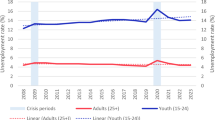Abstract
Average job training subsidies in the Trade Adjustment Assistance Program vary by state due to the cost of particular training programs chosen by participants. This study partitions the higher and lower subsidy states from 2010 to 2014 and estimates differences in the effectiveness of their average subsidy levels on reemployment and subsequent earnings. The rationale for partitioning is that higher cost programs tend to be more occupation or skill oriented than lower cost programs and might, therefore, be more effective. There is found to be only a small increase in the rate of reemployment with increases in the subsidy across all states, though it is fractionally higher in the higher subsidy partition. The contemporaneous state-level macroeconomic conditions have virtually no effect on the rate of reemployment. There is also a small increase in subsequent earnings as the subsidy increases, but only in the lower subsidy partition. Increases in earnings across all states are attributed to the state-level macroeconomic conditions, particularly inflation. These findings emerge from a different empirical approach than taken in earlier studies, but corroborate that the program's job training requirement has been only moderately effective overall, though better at promoting reemployment than higher earnings.
Similar content being viewed by others
Notes
A complete list of allowable training is found at U.S. Department of Labor, Education and Training Administration (2009).
More detail about job training waivers is found at U.S. Department of Labor, Education and Training (2002).
In each year, one or more states did not report certain macroeconomic data to the U.S. Department of Commerce, Bureau of Economic Analysis, as needed to complete the empirical work in this study. The number of states not reporting in each year is seven in 2010, eight in 2011, one in 2012, one in 2013 and three in 2014. The dataset, therefore, totals 230 states for the five years rather than 250.
Since many acceptable programs are offered online as distance learning, the training program chosen need not be physically located in the state where the participant resides.
Increases in TSE and %∆TSE are preferred to declines in the state unemployment rate as potential drivers of reemployment and earnings because the unemployment rate can fall due to workers dropping out of the labor force, not because labor market conditions are improving. In fact, this is known to have occurred within the timeframe of this study.
States were required to submit their TAPR data to the Department of Labor beginning in 1999, but online posting did not begin until 2010.
Each annual edition of TAPR is updated with data on %EE and AE after the relevant six-month periods have occurred. In each regression, therefore, all data on these variables correspond properly in time with the data on SUB.
An alternative explanation for choosing a lower-level program is that some might do so in a perfunctory fashion merely to continue to qualify for TAA income support. The risk of this moral hazard clearly accompanies the training requirement, but there remains total uncertainty as to how many participants actually have this motivation.
References
Bohanon, C. E., & Flowers, M. (1998). The unintended consequences of trade adjustment assistance. Cato Journal, 18(1), 65–74.
Charnovitz, S. (1986). Worker adjustment: The missing ingredient in trade policy. California Management Review, 28(2), 156–173.
Decker, P. T., & Corson, W. (1995). International trade and worker displacement: Evaluation of the trade adjustment assistance program. Industrial and Labor Relations Review, 48(4), 758–774.
Marcal, L. E. (2001). Does trade adjustment assistance help trade displaced workers? Contemporary Economic Policy, 19(1), 59–72.
Reynolds, K. M., & Palatucci, J. S. (2012). Does trade adjustment assistance make a difference? Contemporary Economic Policy, 30(1), 43–59.
U.S. Department of Commerce, Bureau of Economic Analysis (2010–2014). www.bea.gov/regional/index.htm.
U.S. Department of Labor, Education and Training Administration (2002). Trade Act Participant Report. www.doleta.gov/tradeact/2002law.cfm.
U.S. Department of Labor, Education and Training Administration (2009). Trade Act Participant Report. www.doleta.gov/tradeact/2009.cfm.
U.S. Department of Labor, Education and Training Administration (2010–2014). Trade Act Participant Report/. www.doleta.gov/tradeact/.
Author information
Authors and Affiliations
Corresponding author
Rights and permissions
About this article
Cite this article
Giordano, J.N. Job Training Subsidies, Reemployment and Earnings in the Trade Adjustment Assistance Program. Int Adv Econ Res 23, 283–293 (2017). https://doi.org/10.1007/s11294-017-9647-7
Published:
Issue Date:
DOI: https://doi.org/10.1007/s11294-017-9647-7




